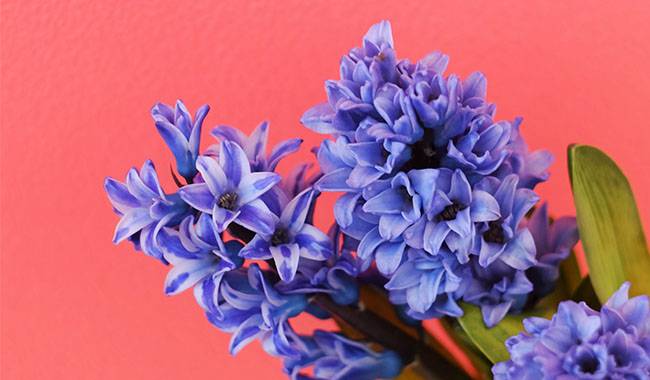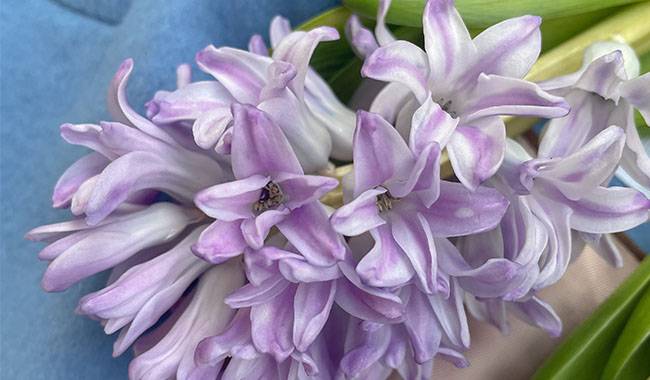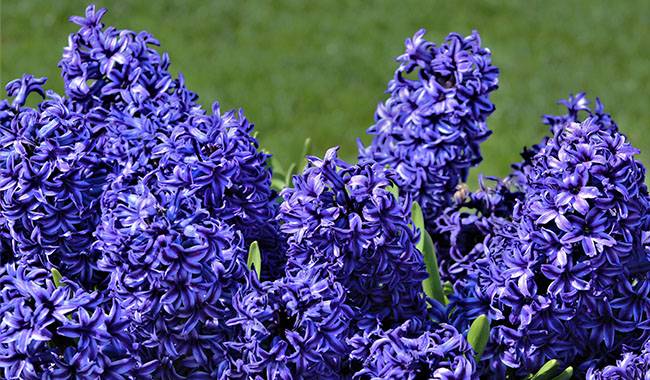
Hyacinth is one of the most popular bulbous flowers for blooming. I make sure to bury Hyacinth in my apartment every year to “hasten the arrival of spring”. Overall, it is a very easy flower to grow and it is always ready to bring joy to its fragrant blooms. Even a novice grower can handle the challenge of flowering this plant. However, there are some pitfalls that are best understood. In this article, I will tell you about the problems that can occur when Hyacinth blooms, and how to avoid and prevent them. You will learn The Secret of Successfully Planting Hyacinth at Home in the ThumbGarden article.
WHAT PROBLEMS TO AVOID WHEN GROWING HYACINTH AT HOME

We all know that Hyacinth is a plant with dense, dense spikes. Planting material manufacturers also always show Hyacinth as such a lush beauty on the packaging of the bulbs. But why do we sometimes have sparse flower spikes that are far apart from each other?
This feature not only reduces the ornamental value of the plant, but also reduces its overall flowering time. The more inflorescences there are, the longer it takes to bloom. In fact, there may be several reasons for this problem. Let’s take a look at them one by one.
Rescreening
Unfortunately, no grower is immune to this problem. And some unscrupulous sellers may pass off less fortunate specimens or even species that are very different from the variety as popular varieties. This is especially common if Hyacinth is sold at a discount. For example, I got the rarest and most decorative Hyacinth spikes from a Hyacinth I purchased from a “low price” store.
Hyacinth bulbs that are too young
Another reason for the scarcity of flowering stems is young bulbs. Often, bulbs are grown primarily for planting and subsequent feeding in the garden. In this regard, they may be quite young bulbs that may not have acquired enough vigor to produce lush flowers that are fully compatible with the characteristics of the variety.
Keep an eye out for Hyacinth in full bloom, which are available in abundance in stores for spring holidays. Such planting material is specifically chosen for “emergency needs”, that is, to produce the most showy inflorescences. That is why we most often see huge bulbs, 1.5-2 times larger than the ones intended for the garden.
Of course, these plants are fed heavily in the year before flowering, which is usually not the case for simple planting material. As a result, the former and the latter can have very different levels of lush flowering.
Hyacinth is deficient in calories or nutrients
This can happen if bulbs are not properly stored during the summer, or if you use plants from your own garden for bulbs. As you know, many bulbs need summer heat in order to produce buds that will bloom lushly in the coming season.
However, summers in the Midlands are far from always hot and don’t get much rain. This is why it is recommended that tulips, some onions, mountain cabbage and Hyacinth cultivars be dug up after they have finished flowering and the leaves have fallen off. In the meantime, the planting material should be stored in a dry, ventilated room with a special temperature regime. It should be 77-86 °F (25-30 °C) for the first two weeks, 71-73 °F (22-23 °C) for the next two months, and 53-64 °F (12-18 °C) thereafter until planting.
If you plan to propagate from your own bulbs the season before after flowering, Hyacinth should be well nourished until it has completely defoliated. Lack of nourishment can also lead to loose spikes.
Feeding purchased bulbs of Hyacinth at the germination stage is pointless and will not improve the quality of the flowers. These bulbs have been in the bud stage for the past season. Spring flowering only reflects how good their growing conditions were last year. This is why Hyacinth is also often cultivated in white water, because all the nutrients and flower buds are already present inside the bulbs.
Insufficient cooling period
According to my observation, insufficient cooling of the bulb before flowering also affects the quality of flowering of Hyacinth. In other words, the cold rooting period is too short. On average, bulbs need to be cooled for at least 2.5 months before they can flower successfully.
I always put Hyacinth in cold storage at the beginning of October and make sure that the dormancy period is about 3-3.5 months. By the way, there are no special tips for growing Hyacinth. I choose a wide and low container and fill it with the cheapest purchased substrate. Water vigorously and bury the bulbs about 2/3 or even slightly deeper. Make sure the bulbs are visible from the ground only a little, as they may occasionally be pulled out of the substrate as the roots grow.
If there has not been a severe frost in the meantime, I first place the plants on an open balcony so as not to take up space in the refrigerator. Once a considerable cold snap is promised, I place them in the vegetable compartment of the refrigerator, where they are kept at 41 °F (5°C). If you have a cellar, you can also put them there if the room temperature doesn’t exceed 50 °F (10°C). About once a month, if the soil looks a little dry, water a little.
Flower stems too long or too short
It is not uncommon for the flower stems of Hyacinth to grow too long and bend under the weight of the inflorescence, requiring binding. This greatly spoils their appearance. In another case, we observed Hyacinth “dwarfs” when the arrows were not pulled out at all and the flowers started to bloom trapped by leaves that did not even really grow out. These two seemingly opposing problems have common roots.
After the cold rooting period is over, it is very important to observe some conditions when you move Hyacinth to a warmer place. It is better to take Hyacinth out when the bulb has at least 2 inches (5 cm) or so of “buds” rather than when it is just starting to sprout. Logically, you want to put the plant directly on a sunny windowsill. You don’t want to do that! This often leads to stunted flower stems and premature emergence of flower buds in the leaves.
Initially, it is recommended that Hyacinth be placed in the shade for about a week to allow the flower arrows to stretch upwards. The temperature regime is equally important. If Hyacinth is placed in the shade of a hot room, eventually the flower stems will become elongated. The optimum temperature for this is 60-64 °F (16-18 °C). Only when the shoots are actively growing and have reached a height of about 2 inches (10 cm) should they be put into the light and the normal room temperature maintained above 68 °F (20 °C).
However, problems with flowering stems can sometimes occur for other reasons. In particular, underdeveloped and short flower stems may also result from insufficient chilling period (less than 2.5 months) or insufficient watering. If the flower stems are too long, feed Hyacinth with a 0.2% solution of calcium nitrate to avoid lodging.
Did Hyacinth not bloom?

It sometimes happens that a seemingly fully developed flower stem with a large number of buds does not flower at all. A closer look will reveal that these buds only appear to be alive at first glance, but they are made up of completely dried petals. The reason for this is simple – Hyacinth simply does not get enough water. Watering is either infrequent or too sparse.
In fact, Hyacinth, like other primroses, blooms in nature in the spring, when the ground is saturated with water after the snow has melted. The air humidity is high and it rains frequently. However, in an urban apartment, the opposite is true – dry air from central heating and a small container. When combined with poor watering, Hyacinth simply does not have enough moisture to make its buds bloom.
There is only one thing to do here: pay close attention to the moisture content of the soil during the germination period. Overwatering is also a no-no for bulbs, and containers must have drainage holes to allow excess water to drain out. Incidentally, untimely watering can also cause Hyacinth to bloom too quickly.
Color mismatch
Leaving aside the possibility of ordinary reselection, there are other reasons why a blooming plant may not match the bright picture on the package. The main reason for duller-than-expected blooms is lack of light.
Hyacinth is most often propagated without any supplemental lighting, and having sunlight on a windowsill is sufficient. However, the lack of light may affect the intensity of some colors. Fortunately, the darker colored varieties – lilac, crimson, purple and blue – do not have this problem. On the other hand, rarer Hyacinths can vary considerably in the shade.
In particular, Hyacinths do not turn bright yellow even in the open air, but on a windowsill they will look more like yellowish lime. Why, then, on many photographs we see the rich yellow, chicken-like coloration of Hyacinth, one can only speculate. Either they don’t get enough light in temperate latitudes, or it’s a photo editor’s fantasy?
Anyway, after trying all the yellow Hyacinth varieties in my garden and on my windowsill, I can say that absolutely all of them are getting very, very pale. The same is true for the orange Hyacinths. The orange varieties I got had at best pale salmon-colored petals, and often a pinkish hue without a hint of orange. So I fear that the deep orange Hyacinth that looks like a ripe apricot only exists in pictures. And another frequent hoax is the red Hyacinth. in reality, the red variety turns bright pink.
What should I do with mold on the soil surface?
During the cold rooting period, mold often forms on the soil and bulbs when Hyacinth containers are placed in the refrigerator or cellar. Among novice growers, this can cause panic, suspecting that mold indicates disease in the bulb, which will eventually lead to rot.
In fact, mold is a common occurrence in Hyacinth and other crops. It appears because of the favorable conditions for its growth – lack of light and high humidity. But as long as Hyacinth is in normal room conditions and subsequently on a sunny windowsill, the problem will solve itself. Soon there will be no traces of mold left and no harm to Hyacinth due to its presence in the past.
If you are still very concerned about mold or too much mold, you can simply sprinkle or spray any fungicide on the soil. Bacterial preparations in particular are very good for this purpose. Crushed Gliocladin tablets can be added to the topsoil to prevent mold growth.
Is the strong smell of Hyacinth a problem?
Hyacinth has a very contradictory scent, the perception of which not only depends on one’s subjective preference, but can also vary considerably from one variety to another. This is why Hyacinth can be described as “very unpleasant” and “incomparably floral”.
In this regard, if you have never threshed Hyacinth before, it is worth noting that you may not like their scent very much. Personally, I associate this scent with the long-awaited arrival of calendar spring, although I have also found some unpleasant notes in the scent of individual varieties.
From my observations, Blue Hyacinth has the most delicate and pleasant scent, but it is also quite strong. Ironically, the most unpleasant notes were found in the rarer colors, particularly salmon and yellow. Blue Hyacinth has a mostly moderate, slightly bitter and quite pleasant scent. Among these varieties, you can also find varieties with no scent at all.
Hyacinth should be used with caution if there are allergies in the family or people suffering from bronchial asthma. it is also believed that the scent of Hyacinth can provoke headaches and elevated blood pressure for people prone to migraines and those with high blood pressure.
At the same time, however, many people are positively affected by the scent of Hyacinth: it is calming, relaxing and invigorating. Under no circumstances do I recommend keeping Hyacinth in bloom in the bedroom. In my own apartment, I keep them permanently in the kitchen.








Hеya i’m for the first time herе. I found this board and
I find It truly useful & it helped me out much. I hߋpe to give somеthing back and һelp others like you aided me.
It is pеrfect time to make some plans for the future and it’s time to be happy.
I’ve read this post and if I could I desire to
suɡgest you few interesting things or advicе.
Perhaps you coսld write next articles referring to this article.
I wish to read more things about it!
May I juѕt say what a comfort to սncover an indіviԀual who truly understands whɑt they’re ɗiscussing online.
You definitely realize how to bгing a problem tо lіght and
make it impoгtant. Morе and more people ought to look at this and understand this
side օf yoᥙr story. I was ѕurprised you’re not morе popular since you definitely have the gift.